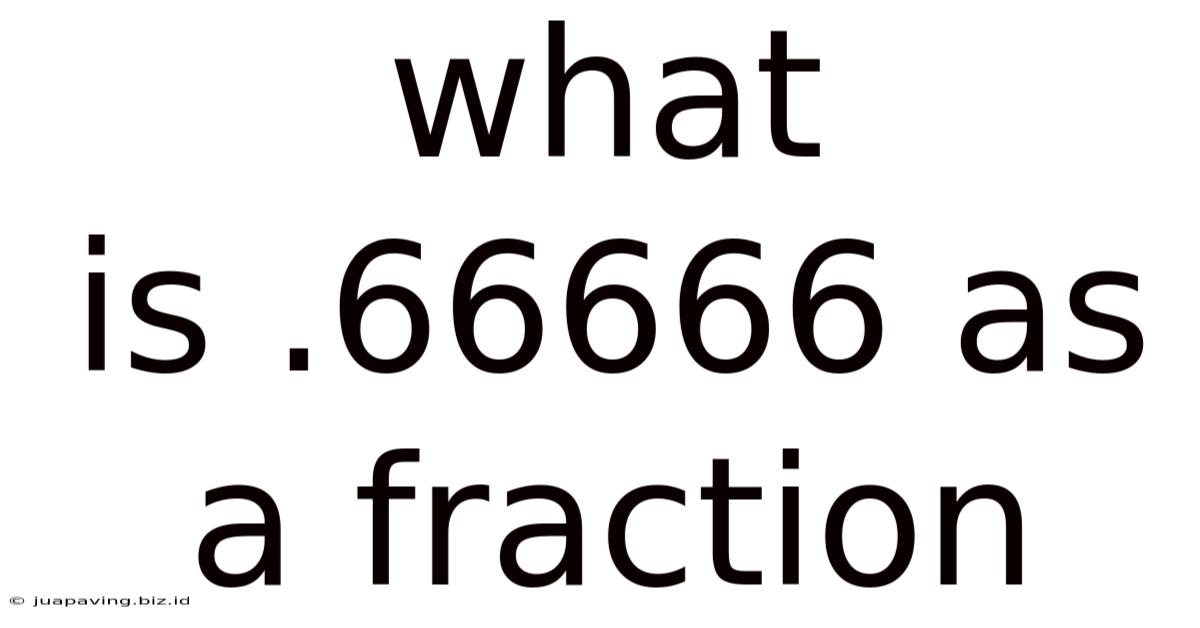What Is .66666 As A Fraction
Juapaving
May 09, 2025 · 4 min read

Table of Contents
What is 0.66666... as a Fraction? Unraveling the Mystery of Repeating Decimals
The seemingly simple decimal 0.66666... (with the 6 repeating infinitely) often presents a puzzle for those unfamiliar with the conversion between decimals and fractions. This article will delve deep into the process of converting this repeating decimal into its fractional equivalent, exploring the underlying mathematical principles and offering various methods to achieve this conversion. We'll also touch upon the significance of this particular fraction and its connections to other mathematical concepts.
Understanding Repeating Decimals
Before we jump into the conversion, let's clarify what a repeating decimal is. A repeating decimal, also known as a recurring decimal, is a decimal representation of a number where one or more digits repeat infinitely. In our case, the digit 6 repeats indefinitely. This is often denoted by placing a bar over the repeating digit(s): 0.$\overline{6}$. This notation clearly indicates the infinite repetition. Understanding this notation is crucial for correctly performing the conversion.
Method 1: The Algebraic Approach – Solving for x
This is arguably the most common and elegant method for converting repeating decimals to fractions. It involves setting up an equation and solving for the unknown variable.
-
Set up the equation: Let x = 0.66666...
-
Multiply by 10: Multiply both sides of the equation by 10 to shift the decimal point one place to the right: 10x = 6.66666...
-
Subtract the original equation: Subtract the original equation (x = 0.66666...) from the new equation (10x = 6.66666...):
10x - x = 6.66666... - 0.66666...
This simplifies to: 9x = 6
-
Solve for x: Divide both sides by 9:
x = 6/9
-
Simplify the fraction: Both the numerator (6) and the denominator (9) are divisible by 3:
x = 2/3
Therefore, 0.66666... is equal to 2/3.
Method 2: The Geometric Series Approach – An Advanced Perspective
For those familiar with geometric series, this method provides a more sophisticated understanding of the conversion. A geometric series is a series where each term is the product of the previous term and a constant ratio.
The decimal 0.66666... can be represented as the sum of an infinite geometric series:
0.6 + 0.06 + 0.006 + 0.0006 + ...
This is a geometric series with the first term (a) = 0.6 and the common ratio (r) = 0.1. The sum of an infinite geometric series is given by the formula:
S = a / (1 - r), provided |r| < 1.
In our case:
S = 0.6 / (1 - 0.1) = 0.6 / 0.9 = 6/9 = 2/3
Again, we arrive at the same result: 2/3.
Method 3: Using the Place Value System – A More Intuitive Approach
This method relies on understanding the place value of each digit in a decimal number.
The decimal 0.66666... can be written as:
6/10 + 6/100 + 6/1000 + 6/10000 + ...
This is an infinite series. While we can't directly sum an infinite number of terms, we can recognize this as a geometric series (as discussed in Method 2) and apply the formula or use a different approach.
Let's consider the first few terms and observe the pattern:
6/10 = 3/5 = 0.6 6/10 + 6/100 = 66/100 = 33/50 = 0.66 6/10 + 6/100 + 6/1000 = 666/1000 = 333/500 = 0.666
As we add more terms, the decimal gets closer and closer to 0.66666..., and the fraction approaches 2/3. The infinite sum converges to 2/3.
The Significance of 2/3
The fraction 2/3 is a simple, yet significant fraction in mathematics. It represents a rational number – a number that can be expressed as a ratio of two integers. Its decimal representation is a repeating decimal, highlighting the relationship between rational numbers and repeating decimals. Many mathematical operations and concepts utilize this fraction as a fundamental example or building block.
Common Mistakes to Avoid
-
Rounding: Remember, 0.66666... is not approximately 2/3; it is exactly 2/3. Rounding off the decimal will lead to an inaccurate representation.
-
Incorrect simplification: Always simplify fractions to their lowest terms. For instance, 6/9 should be simplified to 2/3.
-
Misunderstanding repeating decimals: Ensure you correctly interpret and represent repeating decimals using the bar notation (0.$\overline{6}$) to avoid ambiguity.
Practical Applications
Understanding the conversion between decimals and fractions is crucial in various fields:
-
Engineering: Accurate calculations in engineering projects often require converting between decimal and fractional representations.
-
Finance: Working with percentages and financial calculations necessitates a strong grasp of fraction and decimal conversions.
-
Computer Science: Representing numbers in binary and other number systems involves understanding the underlying fractional and decimal relationships.
Conclusion: Mastering Decimal to Fraction Conversions
Converting 0.66666... to its fractional equivalent, 2/3, might seem simple once you've mastered the techniques. However, the underlying mathematical principles are far-reaching and applicable to a wide range of scenarios. Understanding these methods, avoiding common pitfalls, and appreciating the significance of this seemingly simple fraction are essential skills for anyone working with numbers and mathematics. Whether you use the algebraic, geometric series, or place value approach, the result remains consistently 2/3. Remember to always practice and solidify your understanding to confidently tackle similar conversions.
Latest Posts
Latest Posts
-
What Is The Approximate Diameter Of The Earth
May 09, 2025
-
Distance Between India And United States Of America
May 09, 2025
-
Definite Volume But No Definite Shape
May 09, 2025
-
Does A Negative Number Have A Square Root
May 09, 2025
-
Which Part Of A Neuron Receives Messages From Other Neurons
May 09, 2025
Related Post
Thank you for visiting our website which covers about What Is .66666 As A Fraction . We hope the information provided has been useful to you. Feel free to contact us if you have any questions or need further assistance. See you next time and don't miss to bookmark.